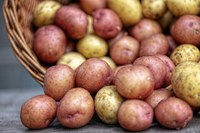Prairie Fare: Pick Some Potatoes for Potassium
(Click an image below to view a high-resolution image that can be downloaded)
By Julie Garden-Robinson, Food and Nutrition Specialist
NDSU Extension
When I was young, my midsummer task was to “sneak” potatoes from the sides of the potato hills in our garden.
We all liked cooked baby red potatoes served with butter, salt and pepper. We usually had fresh green beans and a lettuce salad along with some type of meat to complete our meal from the garden.
As I was looking at my towering potato plants in my backyard garden the other day, I felt a little nostalgic. I didn’t steal any potatoes from the hills, though.
I will let them grow to be large potatoes. I bought some baby red potatoes at the store to make this week’s recipe.
Potatoes sometimes get a bad rap related to their role in a healthful diet. Some people avoid them. However, avoiding potatoes could shortchange you on several important nutrients, including potassium, complex carbohydrates, vitamin C, fiber (especially if you eat the skin) and other nutrients.
If you slather a lot of extra ingredients on your cooked or baked potato, you may please your taste buds. However, you are not doing your overall health a huge favor by adding a lot of calories and, most likely, saturated fat.
Potassium is found in abundance in potatoes. You might be aware that bananas are a potassium source. A medium banana has 425 milligrams of potassium. One medium baked potato with the skin has 925 milligrams of potassium, which is more than twice as much potassium as a similar amount of banana.
Potassium is so important to our overall health that the latest Nutrition Facts labels now feature potassium as one of the listed nutrients. You also will see vitamin D and added sugar on the new labels.
The changes to the label crowded out vitamins A and C. We still need these nutrients, of course.
The nutrition labels were adjusted to focus on nutrients of concern and also keep the nutrition label the same size. You will notice that serving size is in a larger font so it catches our attention.
On average, an adult healthy male age 19 and older needs 3,400 milligrams of potassium and an adult healthy female needs 2,600 milligrams. Aim to get your nutrients from food, and be sure to eat a variety of fruits and vegetables. Milk, yogurt and salmon also contribute significant amounts of potassium to our diet.
Why is potassium so important, anyway?
Potassium is an essential mineral and electrolyte. Our body needs potassium to help our heart and kidneys function. Maintaining the right level of potassium is important for your muscles and organs to function at their best. Having an adequate amount of potassium may help with blood pressure management.
Many Americans do not get the recommended amount of potassium from their diet as a result of shortchanging themselves on fruits and vegetables. About 90% of adults do not meet the daily recommendations for fruits and vegetables, which stands at about 4 1/2 cups in total per day. Our needs vary based on our age and activity level.
Here are a few more examples of potassium-rich foods. One cup of Swiss chard has 961 milligrams of potassium, which is even higher than the amount in potatoes. Three-fourths cup of cooked beans, such as kidney, navy or black beans, provides 541 milligrams. One medium sweet potato with skin has 450 milligrams and 1/4 cup of cooked spinach has 420 milligrams.
Certain groups of people are more likely to have trouble getting enough potassium in their diet. People with inflammatory bowel disease (IBS) such as Crohn’s disease or ulcerative colitis or those who use medications such as laxatives or diuretics are among those who may have issues getting enough potassium.
Older adults who might have health conditions such as high blood pressure, kidney stones or osteoporosis are another group at risk.
Before making major changes in your diet, discuss them with a health-care provider. Some medical conditions require close monitoring of potassium intake.
This recipe was a big hit in my house. We enjoyed it with sauteed green beans, lettuce salad and grilled pork. It reminded me of the meals from my childhood.
Garlic Smashed Potatoes
1 lb. baby red, Yukon Gold or fingerling potatoes
Pinch of salt (kosher or table salt), if desired
4 Tbsp. butter, melted
2 cloves garlic, minced
1 tsp. fresh thyme leaves
Freshly ground black pepper to taste
1/2 c. freshly grated Parmesan
Preheat oven to 425 F. In a large pot, cover potatoes with water and add a pinch of salt. Bring water to a boil and simmer until potatoes are tender, about 15 minutes. Drain and let sit until cool enough to handle. On a large-rimmed baking sheet, toss potatoes with melted butter, garlic and thyme. Using the bottom of a small glass or Mason jar, press down on potatoes to smash them into flat patties. Season with salt and pepper, then sprinkle with Parmesan. Bake until bottoms of potatoes are beginning to crisp and Parmesan is golden, about 25 minutes.
Makes six servings. Without added salt, each serving has 160 calories, 10 grams (g) fat, 4 g protein, 15 g carbohydrate, 2 g fiber and 220 milligrams sodium.
(Julie Garden-Robinson, Ph.D., R.D., L.R.D., is a North Dakota State University Extension food and nutrition specialist and professor in the Department of Health, Nutrition and Exercise Sciences. Follow her on Twitter @jgardenrobinson)
NDSU Agriculture Communication - July 15, 2021
Source: Julie Garden-Robinson, 701-231-7187, julie.garden-robinson@ndsu.edu
Editor: Ellen Crawford, 701-231-5391, ellen.crawford@ndsu.edu




